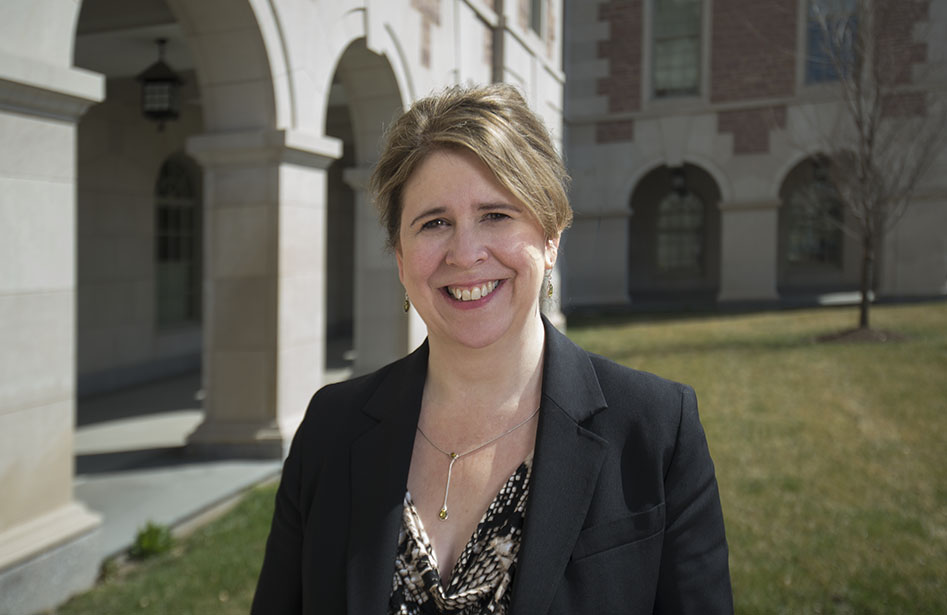When Christine Lorenz, PhD, was growing up, she placed her trust in people who saw a bright future for her. Now, as a vice president at Siemens Healthcare, who leads research and clinical collaborations in molecular imaging, she gives doctors the tools they need to help give patients brighter futures, too.
Growing up in Lake County, Ill., in a family that had bred hunting dogs for generations, Lorenz could have followed in the footsteps of her father and grandfather. But her grandmother, who’d never had the chance to get a strong education, was one of several people in her life who urged Lorenz to find a way to go to college. With the help of a Langsdorf Scholarship, which offered full tuition, she was able to attend Washington University.
Appreciating her undergraduate opportunities — and wanting to help others obtain a similar education — Lorenz has been a longtime supporter of scholarships in the School of Engineering & Applied Science.
Washington University helped hone her capabilities, but even before Lorenz arrived on campus as an undergraduate, she had a strong sense of purpose. She had long been fascinated by a neighbor’s work on dialysis equipment and was eager to explore fields that would allow her to do something similar.
After earning a bachelor’s degree in mechanical engineering, Lorenz headed to Vanderbilt University. There, she became fascinated by medical imaging and went on to earn a PhD in biomedical engineering. She was a member of the faculty at Vanderbilt for seven years before being recruited back to Wash. U. as a faculty member in cardiovascular medicine.
“An academic lab can’t create a $2 million MRI machine from the ground up. It was attractive to be able to influence what gets made and then goes out into the world.”
Christine Lorenz
Her research during this time included using MRI to study heart disease and do clinical imaging. Though it was work she loved, Lorenz eventually realized that to make the kind of impact she wanted, she’d need to move to industry. “In medical imaging, you’re completely dependent on the companies that make equipment — MRI, CT, X-ray [machines] — to provide the instrumentation,” she says. “An academic lab can’t create a $2 million MRI machine from the ground up. It was attractive to be able to influence what gets made and then goes out into the world.”
Lorenz joined Siemens in 2000, and much of her work has been focused on image-guided surgery. While surgery requires extreme precision, opening up people’s bodies is, in a word, messy. With better image-guided software, it’s possible to do surgery that’s much less invasive — and that results in far fewer complications.
For example, a patient who would otherwise be too frail to have her chest opened up to replace a heart valve can undergo a minimally invasive procedure in which a catheter is inserted into her groin up to her heart. With the help of image-guided software, surgeons can put in the new valve using imaging to make sure it’s in just the right place. “It’s basically like a video game for surgeons,” Lorenz says.
Recently, she moved to the Siemens’ molecular imaging group, where she leads work on the technology for PET (positron emission tomography) and SPECT (single photon emission computed tomography) imaging — work that has the potential to help knock out an even bigger baddie: cancer. Right now, for example, it’s possible for doctors to use these imaging devices to detect cancer on the scale of five to ten millimeter lesions. But cancer gets its start at a much tinier scale. By continuing to increase the sensitivity of the equipment, Lorenz is hopeful that doctors will be able to catch more cancers before they spiral out of control.
Perhaps even more important is her desire to make such technology available in places well beyond high-powered academic institutions and major hospitals. “We want to reduce the cost of this technology so it’s more accessible to more people,” says Lorenz, who also holds an MBA.
And it is this kind of vision — the very clearest kind — that can help lead to a better world.
Editor’s note: Washington magazine learned at press time that Christine Lorenz is continuing her service to Washington University and the School of Engineering & Applied Science by accepting an appointment to the Engineering National Council.
